Affiliate links on Android Authority may earn us a commission. Learn more.
Best of Android 2017 - Which phone has the best Audio?
Published onDecember 12, 2017
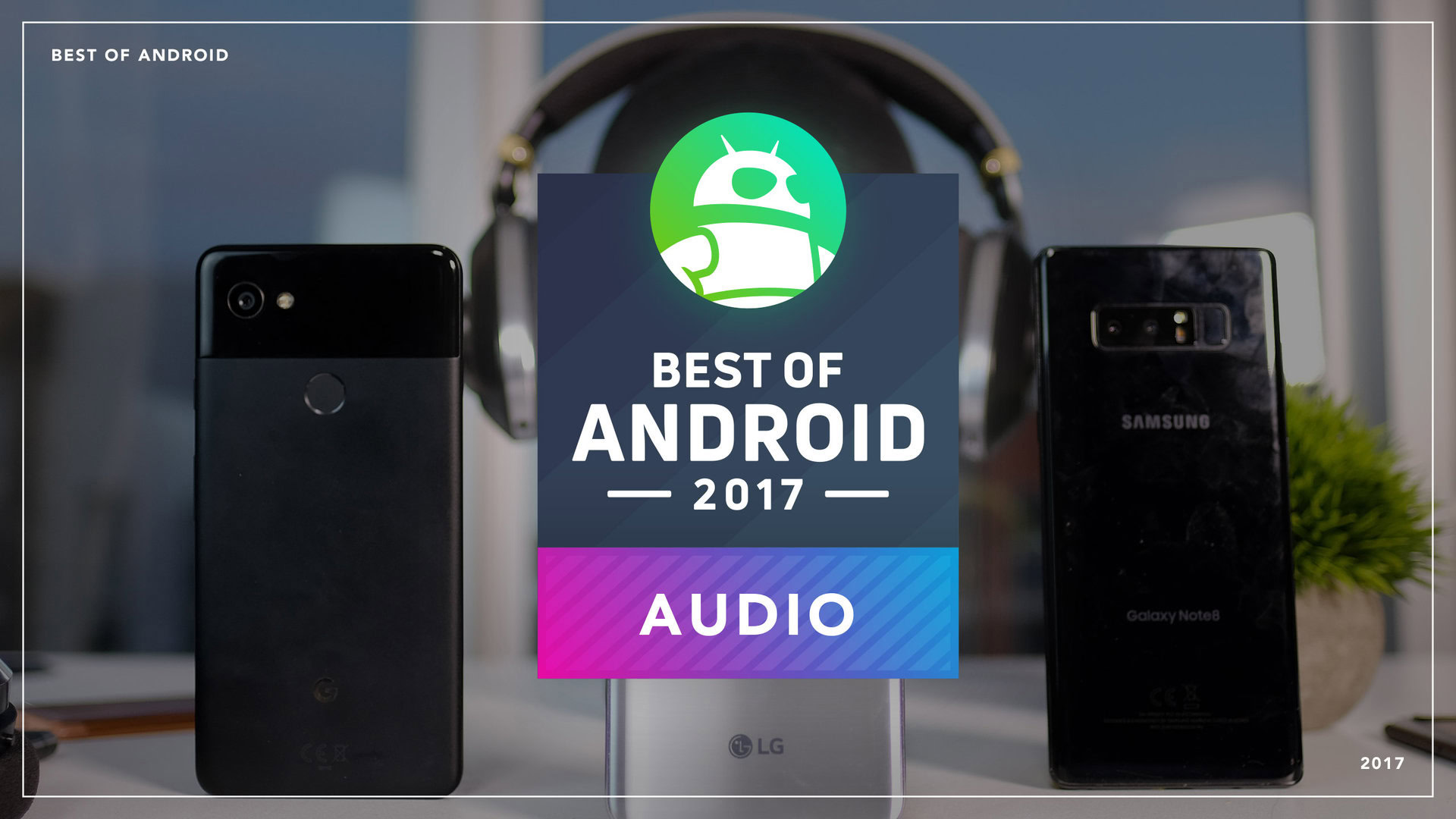
As part of our in-depth Best of Android 2017 edition, we’re taking a closer look at the capabilities of 10 of the best Android flagships to see which comes out on top. Today we’re dealing with audio, a very important quality to look out for, whether you’re streaming your music online, porting around a Hi-Res FLAC library, or looking to listen to movies on the go.
We’ve broken down our testing into three major parts, looking at both the loudspeaker volume, built-in DAC capabilities, and Bluetooth codec support. When it comes to the DAC, we’re looking at the noise level to assess how clean the phone’s signal chain is. The lower the noise floor, the more detail you can pick out from higher resolution files. We’re also taking a look at Total Harmonic Distortion, as this reveals how much, if any, extra distortion information is added to your music. In other words, it’s a good judge of how close the phone is to perfectly reproducing the original source.
The loudest loudspeakers
Let’s start with the loudspeaker. It’s a pretty simply test, we max out the volume of the speaker to get an idea of how easy the phone is to hear while playing back movies and music, etc. This is particularly useful to know if you want to hear a hands-free call in a noisy environment or want to watch a movie while your family chatter away in the living room.
The key thing to remember here is that for every 6 to 10 dB of difference between two sources, the perceived volume doubles. So going from 60 to 70 dB doubles the perceived volume of the source. Decibels are a logarithmic rather than linear scale.
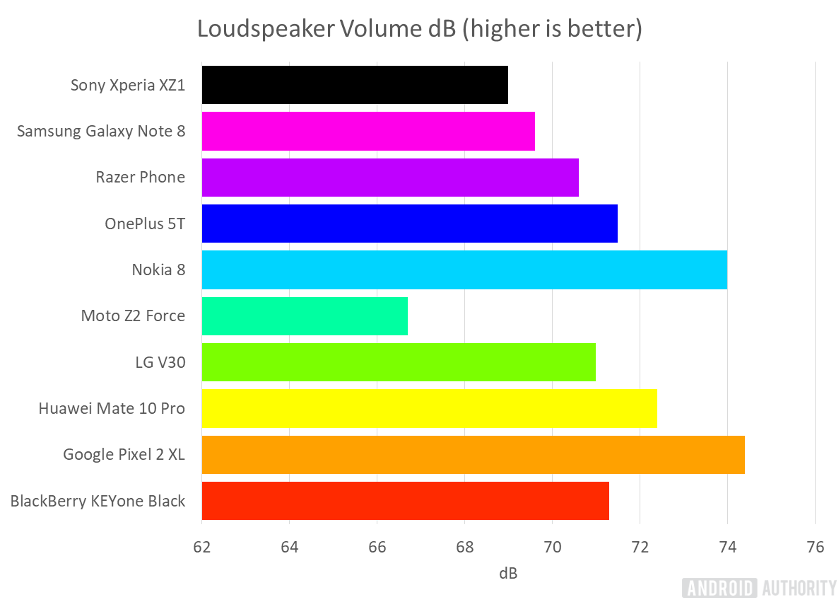
The result above produces two clear winners and one notable disappointment, with the rest of the handsets fielding results that would be difficult to tell apart with your ear. The Nokia 8 and the Google Pixel 2 XL are the loudest phones at 74 dB peak volume, while the Moto Z2 Force will sound almost only half as loud at a mediocre 67 dB peak volume.
For reference, heavy rainfall or a normal conversation clock in at around 60 dB of volume, so all these phones can surpass this marker. Freeway traffic and most household appliances have a volume of around 70 dB, meaning that most handsets will struggle to standout in these environments, with the arguable exception of the two winners. And none of them can compete with the 90 dB volume of a typical subway train.
Listening with headphones
On to the internal DAC and amp, which is the component connected up to your 3.5 mm headphone jack or USB Type-C side-pin ports if your phone doesn’t have a 3.5 mm jack. Again the 6 dB rule applies here, reducing the amount of noise by half. The key marker to look out for is -96 dB, as this is the noise floor that you’ll get from a 16-bit CD file and provides a very clear listening experience. A result below this has potential benefits for Hi-Res or properly dithered CD files, while anything better than -90 dB is perfectly fine for compressed streaming services.
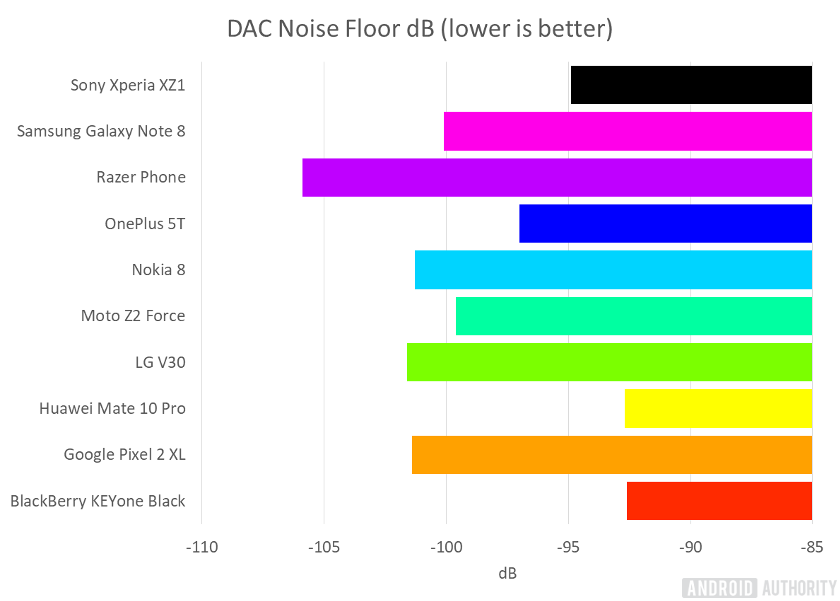
The noise results provide one standout winner, the Razer Phone with -106 dB, which really pushes close to the limits of our testing suite. Other notable mentions include the Galaxy Note 8, Nokia 8, LG V30, and the Pixel 2 XL, which all achieve -100 dB or better, suggesting they’ll benefit somewhat from Hi-Res 24-bit audio. The Mate 10 Pro, BlackBerry KEYone, and Xperia XZ1 fall below the -96 dB market for CD quality, meaning no potential benefits from 24-bit files when listening over wired headphones.
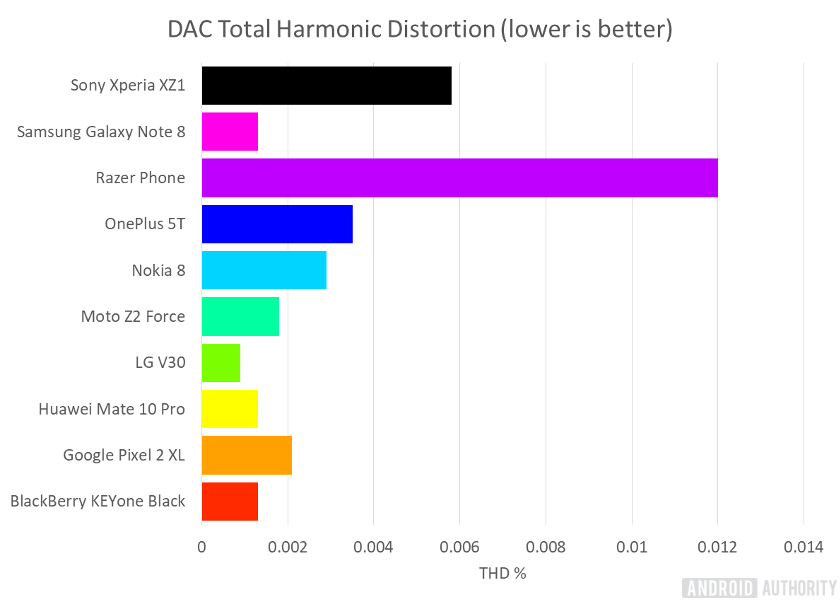
The Total Harmonic Distortion data shakes up the results further though, with a different handset taking a clear lead and two which perform much more poorly. The LG V30 is the winner here at 0.0009%, providing an incredibly clean signal path. The Note 8, KEYone, and Mate 10 Pro are also very close performers with just 0.0013% each. None of the other phones will sound notably distorted, but the results for the Xperia Z1 and more so the Razer phone are below what we would expect from top-tier products. Distortion won’t be horrendous, but those with sensitive ears will definitely be able to hear some undesirable coloration to their music on these phones at louder volumes.
Bluetooth codec support
Finally, with wireless speakers becoming increasingly popular and cableless headphones closing in on the quality of wired models, support for matching Bluetooth codecs is increasingly important. Furthermore, those passionate about music quality might want to take advantage of higher resolution Bluetooth codecs like Qualcomm’s aptX HD and Sony’s LDAC. The table below shows which handsets, according to their spec sheets, are compatible with each major Bluetooth codec.
| A2DP | aptX | aptX HD | LDAC | |
|---|---|---|---|---|
BlackBerry KEYone | A2DP ✓ | aptX | aptX HD | LDAC |
Google Pixel 2 XL | A2DP ✓ | aptX ✓ | aptX HD ✓ | LDAC ✓ |
HUAWEI Mate 10 Pro | A2DP ✓ | aptX ✓ | aptX HD ✓ | LDAC ✓ |
LG V30 | A2DP ✓ | aptX ✓ | aptX HD ✓ | LDAC |
Moto Z2 Force | A2DP ✓ | aptX ✓ | aptX HD | LDAC |
Nokia 8 | A2DP ✓ | aptX | aptX HD | LDAC |
OnePlus 5T | A2DP ✓ | aptX ✓ | aptX HD ✓ | LDAC |
Razer Phone | A2DP ✓ | aptX | aptX HD | LDAC |
Samsung Galaxy Note 8 | A2DP ✓ | aptX ✓ | aptX HD | LDAC |
Sony Xperia XZ1 | A2DP ✓ | aptX ✓ | aptX HD ✓ | LDAC ✓ |
It’s worth remembering that even though Android Oreo now introduces software support for all of these codecs out of the box, it’s still up to OEMs to enable the hardware and pay the correct licenses. As you can see from the table, not every phone supports every codec, even if they’re running Oreo. If you’re looking for phones that support all the codecs, the Pixel 2 XL, Mate 10 Pro, and Xperia XZ1 are your best Bluetooth audio options. That being said, aptX HD support is beginning to reach more and more flagship handsets too, including the LG V30 and OnePlus 5T.
And the winner is…
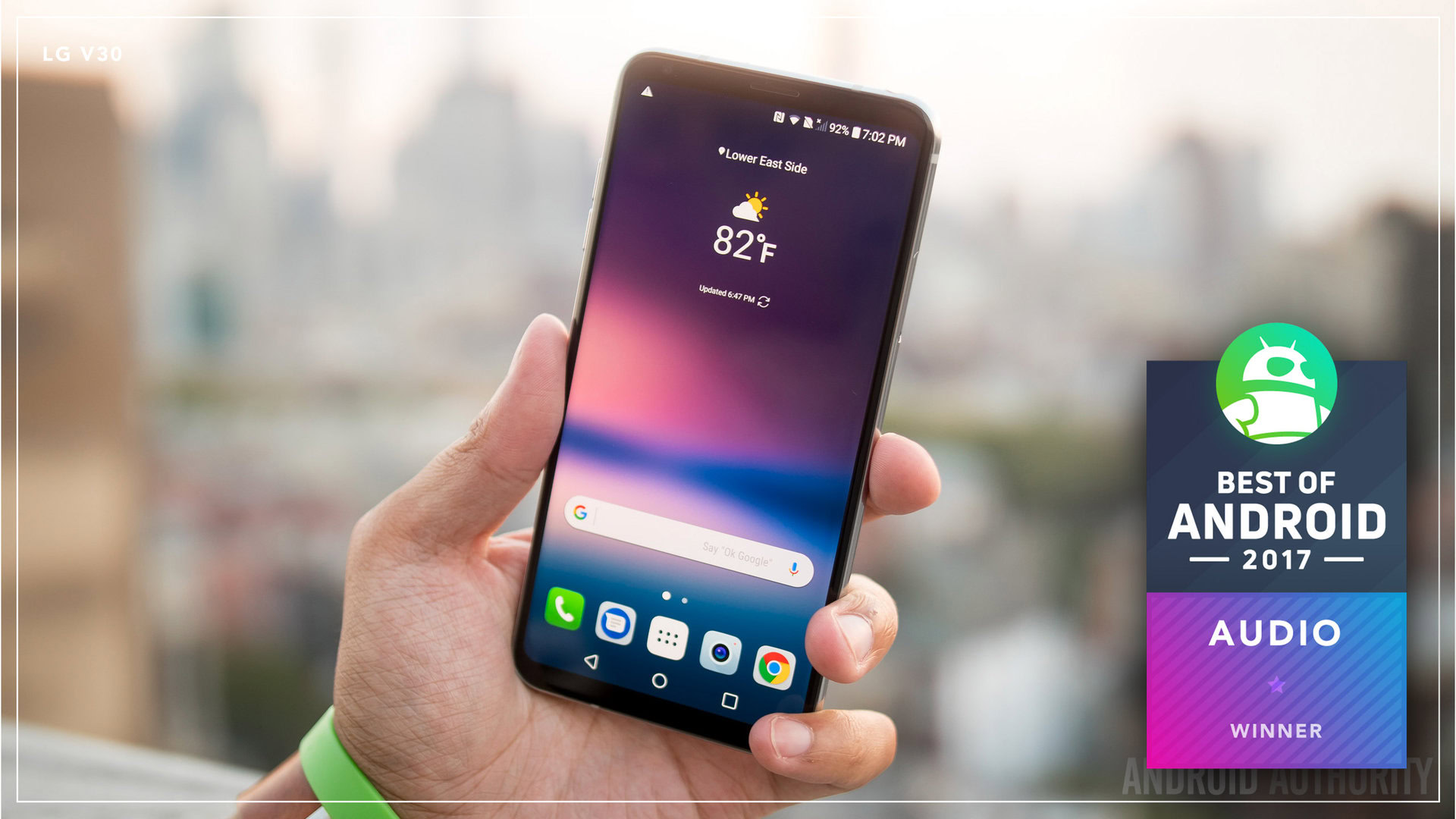
[one_half]
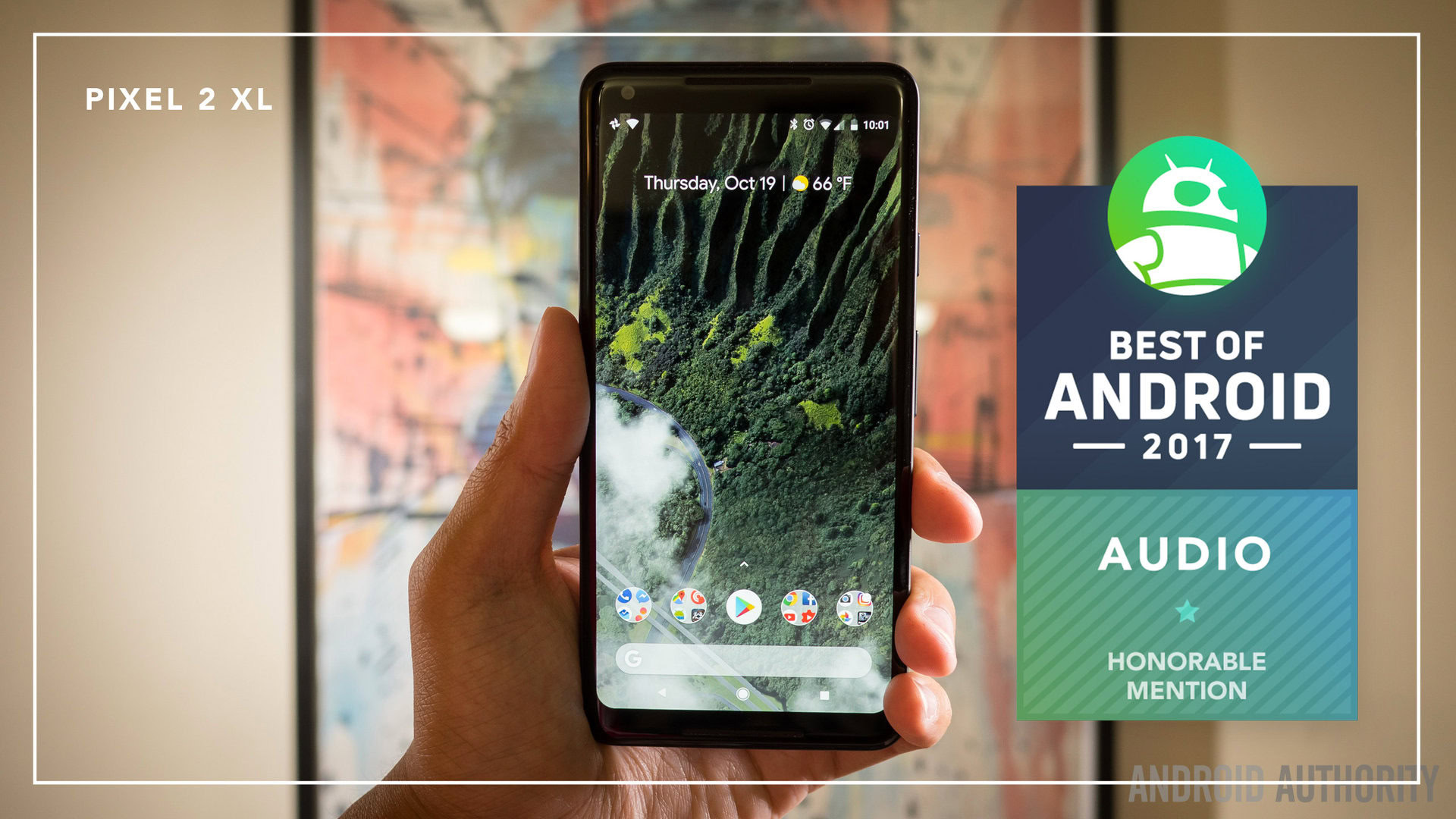
[/one_half][one_half_last]
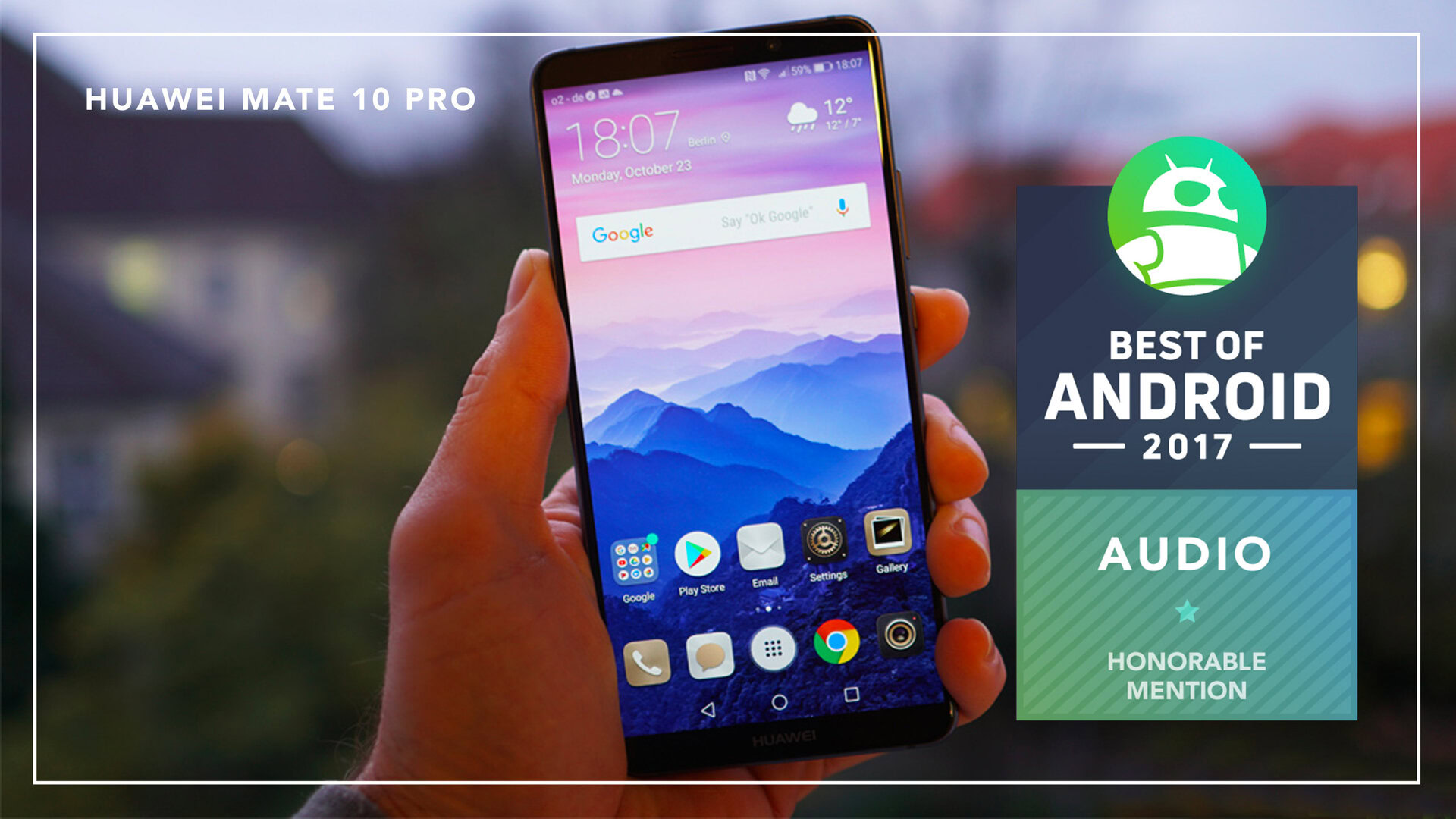
[/one_half_last]
Across all of our testing, it’s the LG V30 that just pips the Google Pixel 2 XL to the post for best in class audio quality. LG certainly hyped up its “Quad DAC” solution and it fortunately sounds just as good as the promises. The phone’s speaker is acceptable too, and you’re also getting aptx HD support for your wireless headphones too.
The Google Pixel XL 2 comes in a very close second, scoring exceptionally well on the speaker test and providing a top-notch listening experience over its USB Type-C port too. If you don’t want to live the dongle life, there’s LDAC and aptX HD support for Hi-Res Bluetooth headphones too.
Third place goes to the HUAWEI Mate 10 Pro. It might not score the best on the headphone output rankings, but an impressively power speaker and support for high quality Bluetooth options make this a compelling choice too. The Galaxy Note 8 and notably lower cost Nokia 8 also score well across the board, and are worthy of honorable mentions.
There you have it, the LG V30, Google Pixel XL 2, and the HUAWEI Mate 10 Pro are your best of 2017 choices if you’re looking for a smartphone with the best audio setups. If you’re looking for some other key attribute for the best smartphone, be sure to check out the other entries in the Best of Android 2017 series.
Which phone do you think is Phone of the year? Vote in our poll below, as the winner will be crowned People’s Choice Smartphone Of The Year 2017!
Remember, we’re giving away the three smartphones that come placed first, second and third in Best of Android! To enter, check out all the details in the widget below and for five extra entries, use this unique code: BOAA17.
Credits
Series Contributors: Rob Triggs, Gary Sims, Edgar Cervantes, Sam Moore, Oliver Cragg, David Imel
Series Editors: Nirave Gondhia, Bogdan Petrovan, Chris Thomas
